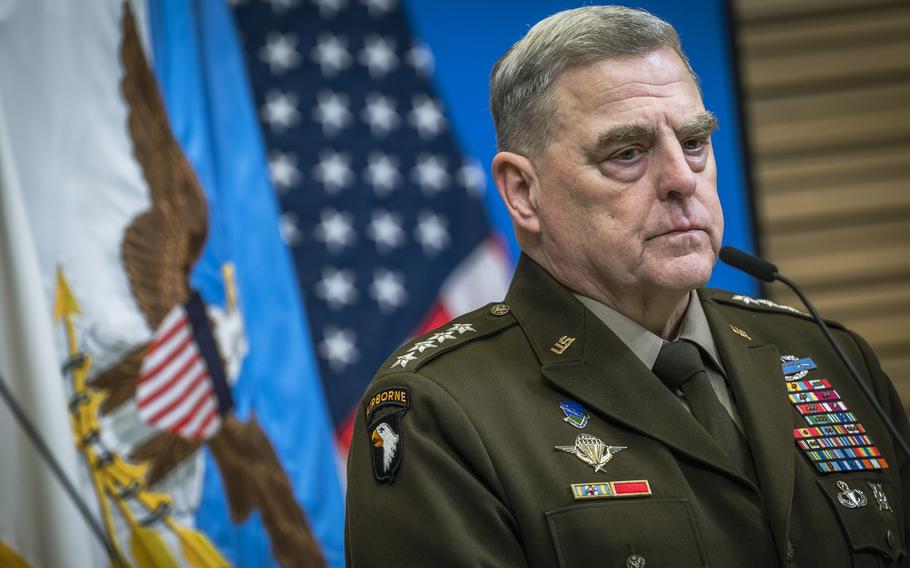
Gen. Mark A. Milley, chairman of the Joint Chiefs of Staff, answers questions during a press conference at NATO headquarters in Brussels, Belgium, on Feb. 14, 2023. Austin hosted the ninth meeting of the Ukraine Defense Contact Group that brought together 54 countries for continuing discussions on support to Ukraine in its war with Russia. (Chad McNeeley/Department of Defense)
BRUSSELS — Time is growing short for Ukraine’s military backers to gather vast quantities of new equipment and move it along supply lines that are fast becoming overwhelmed with shipments Kyiv awaits as it plans to launch a spring counteroffensive against entrenched Russian forces, senior U.S. officials said Tuesday.
From European depots and harbors, to central gathering points and over the border onto the roads and rails of Ukraine, the increasing flow is challenging the ability to transport it in real time, officials said.
There was a palpable sense of urgency as top military and defense officials gathered here for the latest meeting of the Ukraine Defense Contact Group, the coalition of more than 50 nations providing security assistance.
“What Ukraine wants to do at the first possible moment is to . . . create momentum and establish conditions on the battlefield that continue to be in its favor,” U.S. Defense Secretary Lloyd Austin said at a news conference.
“We believe there will be a window of opportunity” for Kyiv’s forces to break through what is essentially a static front line, Austin said. But the effort to bring needed ammunition, as well as new and additional air defense and armor systems to the battlefield, even as they train the Ukrainians to use it, “is a monumental task,” he said.
A senior Biden administration official said there had been “an evolution in the nature of support” from the aid coalition. “I remember the days when we thought Patriots were never going to happen,” the official said, referring to sophisticated Patriot air defense systems that the United States, Germany and the Netherlands have now agreed to supply. “I think everybody is looking around the table and saying what more” can be provided.
But “the other thing I think is not appreciated is how stinking hard it is to get all these things into Ukraine as a coherent package,” said the official, who spoke on the condition of anonymity because they were not authorized to speak on the record.
Three main transportation hubs currently are used to gather equipment going into Ukraine — in Poland, Slovakia and Romania. Without a major effort to move supplies off bases and to the border quickly, there are concerns the arteries will get backed up and the weaponry will get stuck.
“We’re concentrated on giving them kit, but we want to give them full capability” to launch the counteroffensive. “If people want to wait until the end of March to send this stuff into Ukraine, the three transport nodes that we’re currently using will be completely saturated and [it] won’t get there in time. . . . That’s what makes this short window even shorter,” the official said.
Once the donated military hardware gets through the hubs to the border, Ukrainians pick up equipment for distribution inside the country. The more that is moving at any one time, officials said, the greater the potential for logjams.
Inside Ukraine, convoys “are subject to Russian attack,” Gen Mark A. Milley, chairman of the Joint Chiefs of Staff, said at the news conference with Austin. “They maintain good operational security, vary times, don’t set patterns, take different routes. . . . I would say that it’s not without risk, but it’s moderate and a success so far.”
The senior official said that “we’re one step ahead” of complications for now. “We’re not in a situation where everything is going to fall apart, but we have to problem-shoot the things we know have been stress points up to now.”
Much of the coordination takes place at the U.S. European Command in Germany, where planners are struggling to get newly provided armored vehicles delivered from ports and other parts of Europe to areas where U.S. and other forces are training Ukrainian troops to use them.
Donor countries are also being encouraged to take the initiative in coordinating a smooth flow of weaponry. Germany, which for months resisted sending its Leopard main battle tanks to Ukraine, is now heading a collection of at least a half-dozen countries that are also donating the Leopards from their own arsenals — dubbed the “panzer group” — to ensure that a steady flow of tanks and infantry fighting vehicles doesn’t clog the transit routes.
Ammunition shortages have also become a problem, as predominantly NATO countries are scrambling to ramp up production to meet Ukraine’s needs and refill their own stocks.
“Ukraine is using an amount of ammunition that we . . . perhaps could not have imagined,” said Dutch Defense Minister Kajsa Ollongren. “Nobody knew on the 24th of February of last year what kind of war this was going to be, how long it was going to be, that it would be a war of artillery and ground troops,” she said.
NATO Secretary General Jens Stoltenberg said the alliance is exploring how to strengthen the defense industry in alliance countries. “In the short run, the industry can increase production by having more shifts, by using existing production facilities more,” he said in remarks Monday.
“But really to have a significant increase, they need to invest and build new plants.”
With some countries having donated their entire stocks of a particular weapon or type of ammunition, “it’s potentially starting to affect alliance defense,” the administration official said. “We’re not there yet, but you see it five or 10 years down the road.”
For the moment, however, donor attention is focused on the here and now. “Spring is just weeks away,” Austin said. “We have a lot to get done.”